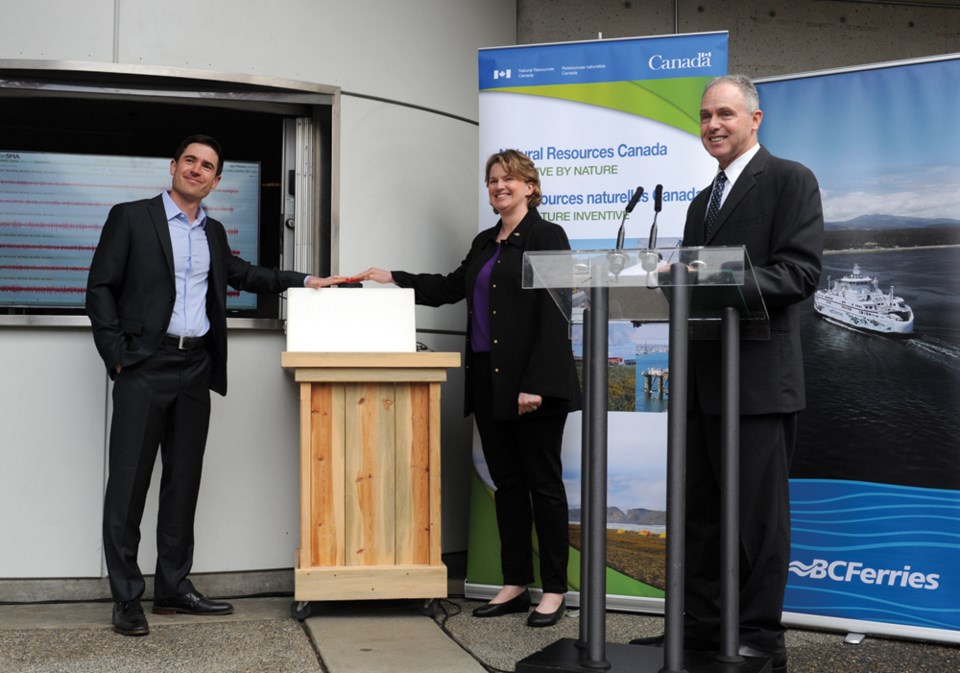If you had 10 seconds’ warning before a major earthquake struck, how would you spend them?
It’s a question Canadians may soon have to ponder, with the nation’s first ever earthquake early warning system getting its launch in West Vancouver.
Natural Resources Canada deployed its first sensor, in what will eventually be a network of 400 sensors in seismically active areas, within BC Ferries’ Horseshoe Bay terminal, Monday (March 28).
The system is designed to detect the first wave of energy radiating from an earthquake’s epicentre and then provide “seconds to tens of seconds” of warning before the real shaking begins.
“Indigenous oral history tells us that every couple centuries, we experienced devastating earthquakes in British Columbia, which today can damage infrastructure, destroy buildings, trigger power outages and displace communities. They can cause injury and even death and they almost always come without warning,” said Patrick Weiler, West Vancouver-Sunshine Coast-Sea to Sky Country, announcing the program on behalf of the federal government. “When an earthquake hits, every second counts.”
Inside the sensor bolted to the floor of the ferry terminal are accelerometers that detect any movement of the ground. When enough movement on enough sensors is picked up, it can trigger the warning. The government expects to have the system fully operational by 2024.
If and when it is triggered, it will use the national public alerting system to deliver instant warnings to smartphones, TVs and radios, similar to how Amber Alerts work today.
“With this system, we will take the guesswork out of the initial response and be able to prepare efficiently for what's coming our way. By giving this heads-up, people will have a few extra moments to drop, cover and hold on,” said Jennifer Rice, B.C. parliamentary secretary for emergency preparedness.
It will also benefit the operators of critical infrastructure who will need a head start mitigating the risk the public and the environment face. With a bit of advanced notice, planes could be diverted from landing and trains could be halted, workers handling hazardous tools or materials could put them down, surgeries could be paused, gates to block the entrances to bridges or tunnels could be deployed, and businesses could start emergency server back-ups.
Similar warning systems are already up and running in Japan, Mexico, Taiwan and U.S. states on the West Coast, where one was triggered by the 2019 Ridgecrest quakes in Los Angeles.
“That was a really good testbed, and it worked really well,” said Alison Bird, earthquake seismologist with Natural Resources Canada. “We have seen this work elsewhere, which is why I'm so thrilled, as a seismologist, to get this in Canada. This is going to make a big difference for us.”
Canada’s new system even uses the same software as U.S. to allow for instant sharing of data, Bird said.
Mark Collins, president and CEO for BC Ferries said the corporation was happy to host the first sensor in their terminal building.
“This was very close to our hearts because, living on the West Coast of Canada, and operating a transportation service, you can't help but be concerned about seismic activity, so we're absolutely thrilled to be part of this initiative,” he said.
B.C. is the most seismically active place in Canada. In 1946, a 7.3-magnitude quake struck Vancouver Island, the largest ever record on land in the country. There have been more than 100 of magnitude five or greater since then, and almost every day, seismographs pick up lesser tremors along the Juan De Fuca Plate.




